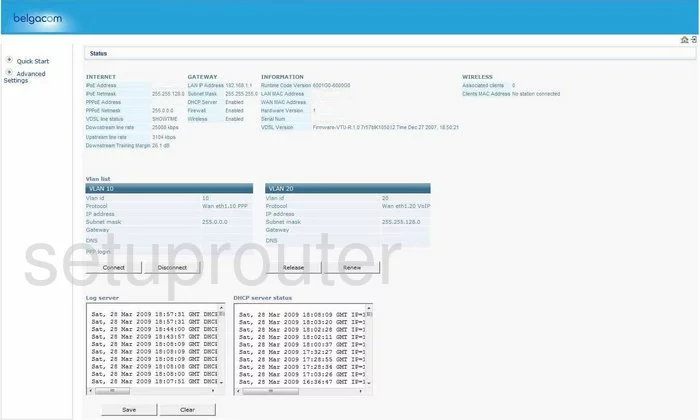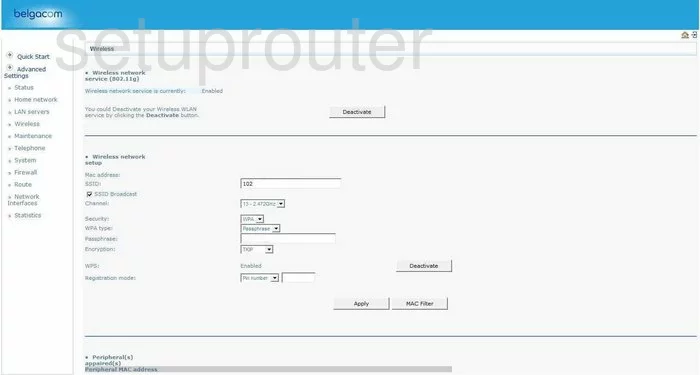The Belgacom B-Box 2 router is considered a wireless router because it offers WiFi connectivity. WiFi, or simply wireless, allows you to connect various devices to your router, such as wireless printers, smart televisions, and WiFi enabled smartphones.
Other Belgacom B-Box 2 Guides
This is the wifi guide for the Belgacom B-Box 2. We also have the following guides for the same router:
- Belgacom B-Box 2 - How to change the IP Address on a Belgacom B-Box 2 router
- Belgacom B-Box 2 - Belgacom B-Box 2 Login Instructions
- Belgacom B-Box 2 - Belgacom B-Box 2 User Manual
- Belgacom B-Box 2 - How to change the DNS settings on a Belgacom B-Box 2 router
- Belgacom B-Box 2 - How to Reset the Belgacom B-Box 2
- Belgacom B-Box 2 - Information About the Belgacom B-Box 2 Router
- Belgacom B-Box 2 - Belgacom B-Box 2 Screenshots
WiFi Terms
Before we get started there is a little bit of background info that you should be familiar with.
Wireless Name
Your wireless network needs to have a name to uniquely identify it from other wireless networks. If you are not sure what this means we have a guide explaining what a wireless name is that you can read for more information.
Wireless Password
An important part of securing your wireless network is choosing a strong password.
Wireless Channel
Picking a WiFi channel is not always a simple task. Be sure to read about WiFi channels before making the choice.
Encryption
You should almost definitely pick WPA2 for your networks encryption. If you are unsure, be sure to read our WEP vs WPA guide first.
Login To The Belgacom B-Box 2
To get started configuring the Belgacom B-Box 2 WiFi settings you need to login to your router. If you are already logged in you can skip this step.
To login to the Belgacom B-Box 2, follow our Belgacom B-Box 2 Login Guide.
Find the WiFi Settings on the Belgacom B-Box 2
If you followed our login guide above then you should see this screen.

Beginning on the Status page of the Belgacom B-Box-2 router. To configure the WiFi settings click the link on the left labeled Advanced Settings. Then below that choose Wireless.
Change the WiFi Settings on the Belgacom B-Box 2

The first thing you need to change is the SSID. This is the name you give your network so you can distinguish yours from those around you. Create an original name but avoid using any personal information here. Check out our guide on the topic if you are interested in learning more, Wireless names.
Next is the SSID Broadcast. This is an optional setting. If you decide to uncheck this box, your network is hidden from any wireless devices in the area that are scanning for networks. This does not mean you are invisible. A hacker can scan for hidden networks with the right tools. All this does is camouflage your network name not make you invisible.
Beneath that is the Channel. This only needs to be changed if you are not on channel 1,6, or 11. You may also decide to change the channel if you are not receiving the reception you think you should. In the United States there are 11 channels you can choose from. Of these 11 channels, there are only three that don't overlap each other, 1,6, and 11. Make sure to use one of these three channels. For more information on this topic, check out our guide titled WiFi channels.
Next is the Security. Here you decide what type of security you want to use for your network. There are several different choices available here. Check out our guide titled WEP vs. WPA for more information on the differences in the security protocols. We recommend using WPA2. It looks as if this router does not offer WPA2, we strongly recommend getting a firmware update to allow for WPA2. WPA2 is the strongest security available right now. If you are unable to upgrade, use WPA.
Under that is the WPA Type. Choose the option of Passphrase in the drop down list.
Now you need to decide what your Passphrase is going to be. The Passphrase is the password you use for your network. You need to create a strong password of at least 20 characters. Avoid using any personal information here. You need to also avoid using any words that can be found in a dictionary. We do suggest using symbols, numbers, and capital letters within the password. For help in creating a strong and memorable password, click the following guide: Choosing a strong password.
The last thing you need to choose is the Encryption. This is referring to how you plan on encrypting your private data. There are two choices here, TKIP and AES. We strongly recommend using AES. AES is the strongest form of encryption available with today's technology.
Finally, when you are finished, click the Apply button near the bottom of the page.
That's it, you did it!
Possible Problems when Changing your WiFi Settings
After making these changes to your router you will almost definitely have to reconnect any previously connected devices. This is usually done at the device itself and not at your computer.
Other Belgacom B-Box 2 Info
Don't forget about our other Belgacom B-Box 2 info that you might be interested in.
This is the wifi guide for the Belgacom B-Box 2. We also have the following guides for the same router:
- Belgacom B-Box 2 - How to change the IP Address on a Belgacom B-Box 2 router
- Belgacom B-Box 2 - Belgacom B-Box 2 Login Instructions
- Belgacom B-Box 2 - Belgacom B-Box 2 User Manual
- Belgacom B-Box 2 - How to change the DNS settings on a Belgacom B-Box 2 router
- Belgacom B-Box 2 - How to Reset the Belgacom B-Box 2
- Belgacom B-Box 2 - Information About the Belgacom B-Box 2 Router
- Belgacom B-Box 2 - Belgacom B-Box 2 Screenshots